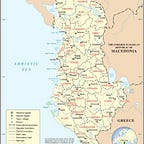Surname diversity in Albania: what does it reveal?
The very first post in this blog examines the frequency and diversity of surnames in Albania in different ways.
Initially, we must dispense with a common misconception about Albanian surnames: the one that exclaims that the three most common surnames are Hoxha, Shehu and Prifti. While all three are indeed very frequent in Albania, with Hoxha leading the way, a look at the evidence shows that the next two rank differently.
We can assume that the reason for the propagation of this claim is likely symbolic: these three surnames are representative of the religious diversity of Albania, with Hoxha associated to Sunni Islam, Shehu to Sufism (especially Bektashism, in the Albanian context), and Prifti to Christianity. Albanian nationalist ideology stresses the fact that Albanian ethnicity was not built upon any religious grounds, and the diversity and coexistence of religious communities serve as the centerpieces of the empirical evidence for this argument.
“The Albanian’s religion is Albanianhood” — Vaso Pasha
Based on 2008 data of the Civil Registry and the 2011 census data from INSTAT (Albania’s institute of statistics)¹, the actual ranking of the top 10 surnames is respectively as follows (left — civil registry; right — census):
The numbers of the table on the right are lower than those of the table on the left because (with relatively few exceptions) the census only represents the people that resided in Albania in 2011, whereas the Civil Registry encompasses every person known to be an Albanian citizen in 2008.
Otherwise, the two lists look both similar and different in certain ways. Hoxha leads the batch by far, and the surnames that make the top 10 do not change from one list to another. The discrepancies within the top 10 ranking can be obviously attributed to the different rates of emigration for people with these surnames. In fact, given Albania’s very high rate of external migration, this is not a surprising finding.
Having established this general frame of reference, we turn our focus to the diversity of surnames in Albania. In order to measure that, a crude but rather effective method can be used: the cumulative frequency of the top 10 surnames divided by the total population. Through that, we can see the proportion of the population holding those surnames. A population with a diverse set of surnames will have a lesser proportion of the population holding the top 10 surnames, while one characterized by a limited range will also have a greater proportion.
By doing such a calculation it turns out that approximately 4.8% of the Albanian population holds one of those top 10 surnames. However, this figure has barely any significance on its own. We need to add context to it: how does it compare to other places and what factors possibly influence this number?
The most interesting and apt comparison can be made with Kosovo, for which we possess similar data. The country neighbors Albania and it conducted a census in 2011 as well, in which 92.9% of the population declared itself ethnically Albanian (note that the census was boycotted² by many Serbs, especially in Northern Kosovo). Below is the ranking of the top 10 surnames in Kosovo based on its 2011 census³:
It is noteworthy that 9 out of the top 10 surnames in Kosovo are tribal ones. There is only one surname that is non-tribal: Hasani. What is even more striking is how that compares to Albania’s list. The frequency of the top 3 surnames in Kosovo is considerably higher than that of Albania’s top 3. In fact, each of the top 3 surnames in Kosovo is more frequent than the single most frequent surname in Albania. The cumulative frequency of the top 3 surnames in Kosovo is also greater than the cumulative frequency of the top 10 surnames in Albania. In total, the share of the population that holds the top 10 surnames is 15.8% in Kosovo, compared to only 4.8% in Albania.
Why is there such a difference? Well, it seems that surname diversity is mostly an inverse function of population homogeneity. This is related by and large to the size of the population and its evolution. Albania has a population of 2.83 million inhabitants, while Kosovo has 1.81 million inhabitants. Larger populations tend to have more subgroups over time, and surnames are a way by which they differentiate among them.
Nonetheless, even if we account for the population size differences, Kosovo’s surname structure remains considerably more homogenous. As previously noted, 9 out of the top 10 surnames in Kosovo are tribal. The tribes in question originate from a relatively restricted geographical area; they are quite similar to one another and have intermarried among them for a long time. Another thing to note is that Kosovo’s Albanian population is well over 95% Muslim Gheg in its background, with a very small percentage of Catholic Ghegs, mostly in endogamous communities.
Albania’s population, on the other hand, is considerably more diverse. Not only does it have people of both Gheg and Tosk groups, as well as mixed ones, but they also come from a larger variety of religious backgrounds: Sunni, Bektashi, Orthodox, Catholic. Even among Tosks, for example, there are subgroups such as Labs and Chams, which have had their own traditions and have remained endogamous at least until the communist regime.
For most of the population in Albania and Kosovo, the adoption of surnames is a rather recent event. During the Ottoman empire the population was registered based on the name and patronym of the individual. Cities were an exception, as individuals and families tended to use surnames to differentiate themselves. Hence, it would be interesting to investigate whether significant regional and urban-rural differences in surname diversity exist, which could also show differences in surname diversity might be related to the development and urbanization of the subcommunities.
We will delve further into it in the next blog post, so stay tuned!
